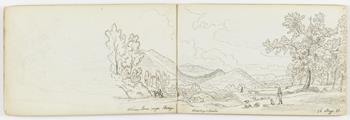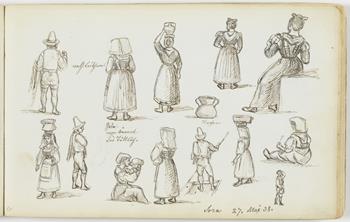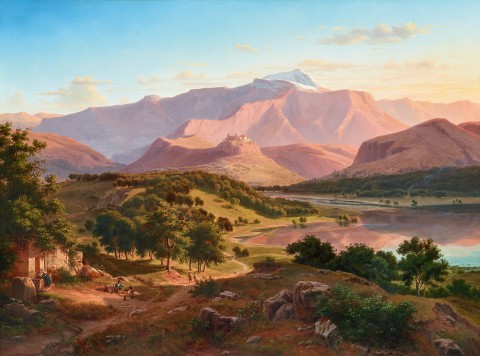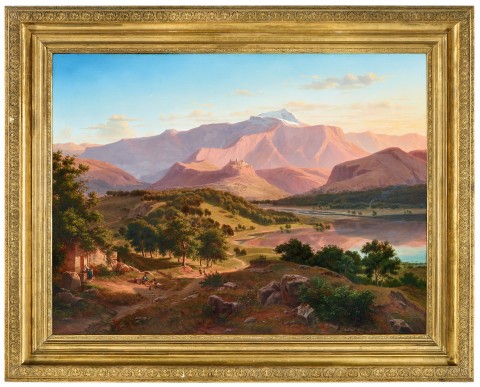DIE BERGE VON ST TENADIO IM NEAPOLITANISCHEN, 1847 (THE MOUNTAINS OF ST TENADIO IN THE NAPLES REGION)
EUGENE VON GUÉRARD
oil on canvas
108.5 x 146.5 cm
signed and dated lower left: Eugen v. Guérard / D. 1847
Dr T. Leurs, Roermond, Netherlands, acquired in 1847
Thence by descent
Private collection, Germany
Sotheby's, Sydney, 22 April 2008, lot 58 (as ‘Italian Landscape’)
Private collection, New South Wales
Annual Exhibition, Kunstverein für die Rheinlande und Westfalen (Art Association for the Rhineland and Westphalia, Düsseldorf), 1847 (as ‘Die Berge von St Tenadio im Neapolitanischen’)
Von Guérard exhibited this major work, his largest known pre-Australian canvas, in 1847 at the Art Association of the Rhineland and Westphalia as Die Berge von St Tenadio im Neapolitanischen [The Mountains of St. Tenadio in the Neapolitan Region].1 The painting depicts the spectacular snow-capped Southern Apennine mountains in the Frosinone province, Lazio, near Sora, their peaks reflected in the famously crystal clear waters of Lake Posta Fibreno. Perched on a rocky hilltop above the lake is the town of Posta Fibreno as it then looked, with the zig-zag road visible on the bare hillside, and towers, which have since disappeared, still standing. It is one of many medieval castled villages found on the hilltops and clinging to the steep walls of this beautiful and history-laden valley, the Val di Comino. Pliny the Elder described the natural wonders of the lake in the 1st century A.D. and, in the 18th and 19th centuries, the Grand Tourists and artists who beat a trail to the picturesque towns of Sora, Isola di Liri and Posta Fibreno – conveniently located halfway between Rome and Naples – included the Naples-based German landscape painter so admired by Goethe, Jacob Philip Hackert, and von Guérard’s Neapolitan colleague, Anton Sminck Pitloo.
Von G 1.jpg

Schneeberge S. Tenadio, vicino Sora, presso Borgo, 26 May 1838
Von Guérard spent three days exploring the region in May 1838 – his first stop on the journey north from Naples to Düsseldorf. On 26 May he sketched the Schneeberge, the snowy mountains, of “St. Tenadio” – it seems that he interpreted San Donato, which is pronounced San Dnat or Sande Denate in the local dialect, as “St Tenadio.” He observed the “beautiful reflections” in Lake Posta Fibreno, the cold clear waters of which are fed by snow melt and springs that rise from an underground limestone karst system. He recorded the flat-bottomed oak fishing boats, the nàue, that are traditional to the region, and on multiple pages of his sketchbook he made detailed, annotated studies of the locals in their distinctive regional dress.2 All of these accurately observed individual elements were drawn together on the canvas that von Guérard painted in his Düsseldorf studio nine years later.
Von G 2.jpg

In this work von Guérard’s superb compositional skills – skills he had been honing throughout 1847 at winter evening gatherings during which he and fellow Düsseldorf artists sketched and critiqued their compositions – are brilliantly realized. Most likely working from a large drawing (now lost) of the type he made on this journey, he has subtly realigned and emphasized the distinctive features of this landscape, bringing them into closer proximity with each other. The composition is structured around a central axis, a serpentine line that leads from the curving path in the foreground, along the contours of the lake’s edge and up to the centrally-located clifftop village. From there, it shifts into a sequence of sweeping arcs, defined by the sharp ridgeline, which culminates in the snow-capped peak. Like a piece of music, this composition is energized by a series of unifying variations, a rhythmic interplay of recurring, counterpointed and inverted landscape forms and contours. Light plays a dynamic role, the low rays of late afternoon sun articulating the mountain architecture, warming the grassy slopes and filtering through the trees. Warm tones, russets and ochres, the deep greens of oak trees, and the dusty pinks and violets of the mountains, speak of a late spring day coming to a close.
As in his best Australian paintings, von Guérard has woven myriad details into a composition distinguished by its uplifting breadth and powerful geometry. Following the winding path into the landscape we, like travellers, discover a valley alive with activity, its cultural traditions and natural diversity revealed in the minute and lively details observed by the artist: a woman, wearing the elaborate traditional dress for which the region known – a full-sleeved white blouse with a red bodice, full blue skirt with trim, embroidered apron and the starched, flat-topped linen head dress designed for carrying vessels – fills her terracotta urn at the fountain; two young men in the white shirts, knee-length breeches and the tall cone-shaped hats of the region relax at the end of the day. Unexpected vignettes materialize with close inspection: two men and their donkey make their way along the shadowed path on the left of the canvas and a woman pauses at the shrine on the steep diagonal path up to the village. Details such as the exposed roots of an oak tree, individuated blades of grass, wildflowers, rambling dog-rose and banks of sedge at the lake’s edge reflect the emphasis placed upon the close study of nature by the Düsseldorf school of landscape painters, and the artist’s acute memory of the site.
In its scale, compositional sophistication, handling of light and colour and in its successful integration of extraordinary levels of closely observed detail, this work reveals an artist – von Guérard had then completed his training at the progressive Düsseldorf Academy and he was working alongside some of the most respected landscape painters of the Düsseldorf School – reaching his full maturity. In every stroke of the brush, this painting expresses the connection that von Guérard felt with this very special part of the world.
I would like to thank Paolo Accettola, Sora historian, and author of Artisti e Viaggiatori del XVII -XIX Secolo a Casamari e Presso San Domenico di Sora, Centro di Studie Sorani “Vincenzo Patriarca” and Monastero di San Domenico Abate, Sora, Italy, 2019, for his generous and informed advice on the physical landscape portrayed by von Guérard, and Dr Ilenia Carnevale, Director, Museo Archeologico di Atina e delle Valle di Comino “G. Visocchi”, Italy, for her much-appreciated assistance.
1. Kunstverein Bericht, Vol. 18 , Düsseldorf, 1847; Rhein- und Mosel-Zeitung, No. 194, 24 August 1847, p. 3. The region was part of the Kingdom of Naples until 1860.
2. In 2008, Candice Bruce linked this work with the Sora region on the basis of the traditional costumes worn. Bruce, C. ‘Eugene von Guérard, Italian Landscape 1847,’ Sotheby’s, Sydney, 22 April, 2008, p. 114.
DR RUTH PULLIN

